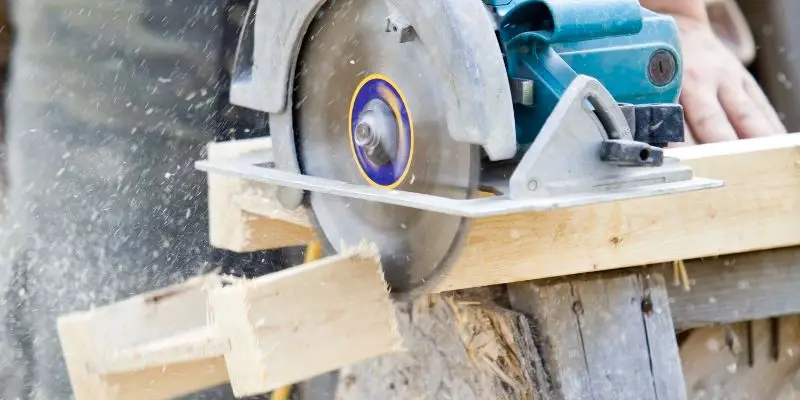To use a sawhorse, simply unfold and position it, ensuring the legs are secure and level. Then, place the material to be cut on top and proceed with sawing.
A sawhorse is a versatile tool that provides stability and support for various DIY projects and construction tasks. Whether you are cutting wood, painting, or building furniture, a sawhorse can be a helpful companion. Its sturdy, collapsible design allows for easy transportation and storage.
We will explore the basic steps to effectively use a sawhorse, along with some tips and precautions. By following these guidelines, you can enhance your safety and efficiency, as well as achieve accurate and precise results in your woodworking endeavors. Let’s dive in and learn how to make the most of this indispensable tool.
Choosing The Right Sawhorse
When it comes to completing various woodworking or DIY projects, having a reliable and sturdy sawhorse is essential. A sawhorse is a versatile tool that provides stability and support while you work on your project. However, not all sawhorses are created equal, and choosing the right one for your needs is crucial. In this section, we will discuss the different types of sawhorses available and the considerations you should keep in mind when selecting one.
Types Of Sawhorses
Before selecting a sawhorse, it’s important to understand the different types available and their specific features. Here are three common types of sawhorses:
| Type | Description | Advantages |
|---|---|---|
| Traditional Sawhorse | A classic design with four legs and a top beam |
|
| Folding Sawhorse | Designed with collapsible legs for portability |
|
| Adjustable Sawhorse | Features adjustable height and width capabilities |
|
Considerations For Selecting A Sawhorse
When selecting a sawhorse, you need to take into account specific factors to ensure it meets your needs and provides optimal performance. Here are some considerations to keep in mind:
- Weight Capacity: Assess the maximum weight the sawhorse can support. It’s important to choose a sawhorse that can handle the weight of your materials or equipment.
- Stability: Look for sawhorses with anti-slip features or rubberized feet to prevent wobbling or shifting during use.
- Portability: Consider whether you need a sawhorse that can be easily transported or stored. Folding or collapsible sawhorses are ideal for those who require mobility.
- Durability: Ensure the sawhorse is made from sturdy materials such as steel or heavy-duty plastic to withstand regular use and heavy loads.
- Height and Width Options: Depending on your project requirements, choose a sawhorse with adjustable height and width capabilities to accommodate different tasks.
- Accessories: Some sawhorses come with built-in clamps, tool holders, or other accessories that can enhance your workflow. Consider if these additional features would be beneficial for your projects.
By considering these factors and understanding the different types of sawhorses available, you can make an informed decision and choose the right sawhorse that perfectly suits your needs. Remember to prioritize stability, durability, and functionality to ensure a smooth and efficient working experience.

Setting Up A Sawhorse
Learn how to set up a sawhorse effortlessly with our simple guide. Discover step-by-step instructions on how to use a sawhorse effectively for your woodworking projects.
Preparing The Work Area
Before setting up a sawhorse, it is crucial to prepare the work area adequately. This step ensures your safety and helps you work efficiently. Here are some important things to consider:
- Clear the space: Remove any unnecessary clutter or debris from the area where you plan to use the sawhorse. This prevents accidents and allows for a smoother workflow.
- Check for level ground: A level surface is essential for stability. Use a level or a straight edge to confirm if the ground is even. If needed, make adjustments by adding or removing materials underneath the sawhorse legs.
- Secure the materials: If you’re working with long or heavy materials, such as lumber, secure them properly on the ground to prevent any unexpected movement during sawing. You can use clamps, weights, or any other suitable method.
Positioning And Leveling The Sawhorse
Once you have prepared the work area, it’s time to position and level the sawhorse for optimal performance. Follow these steps:
Step 1: Placement
Decide on the placement of the sawhorse to ensure it offers stability and convenience. Consider the length of the material you’ll be working with and the space you have available. Placing the sawhorse too far apart may lead to instability, while positioning them too close can limit your workspace.
Step 2: Align the Legs
Before setting up the sawhorse, make sure its legs are aligned correctly. Ensure that each leg is parallel to one another and perpendicular to the ground. This alignment helps maintain stability and prevents wobbling during use.
Step 3: Leveling the Sawhorse
A level sawhorse is essential for accurate cutting and a balanced working surface. Here’s how you can level it:
- Place a level across the top surface of the sawhorse.
- Adjust the length of each leg as necessary by using a sawhorse leg support or by adding shims.
- Recheck the level to ensure all legs are adjusted correctly.
Remember, a stable and level sawhorse goes a long way in creating a safe and efficient workspace. By following these steps, you can set up your sawhorse properly and be well on your way to completing your woodworking projects with ease.
Using A Sawhorse Safely
When it comes to using a sawhorse, safety should always be the top priority. Whether you are an experienced carpenter or a DIY enthusiast, taking the necessary precautions will help prevent accidents and ensure a smooth working process. In this article, we will discuss two key aspects of using a sawhorse safely: wearing appropriate safety gear and avoiding common mistakes.
Wearing Appropriate Safety Gear
Before starting any woodworking project, it is essential to wear the right safety gear to protect yourself from potential hazards. When using a sawhorse, these are the safety items you should have:
- Safety glasses: Protect your eyes from wood chips, dust, and flying debris that may be produced while sawing. Choose impact-resistant safety glasses that comply with safety standards.
- Hearing protection: Sawing can be noisy, especially with power tools. Wearing earplugs or earmuffs will help preserve your hearing in the long run.
- Gloves: Choose gloves that provide a comfortable grip without compromising on safety. They will protect your hands from splinters, cuts, and other injuries.
- Dust mask: Sawing and sanding can produce a significant amount of dust that can irritate your respiratory system. Use a dust mask to filter out particles and keep your lungs safe.
- Appropriate footwear: Closed-toe shoes with non-slip soles are crucial to prevent accidents caused by slipping or falling objects.
Avoiding Common Mistakes
When using a sawhorse, being aware of common mistakes can save you from accidents and ensure efficient work. Here are some frequently encountered mistakes and how to avoid them:
| Mistake | Prevention |
| Sawing without proper support | Ensure the workpiece is firmly secured to the sawhorse with clamps or other suitable methods. This will prevent the wood from moving while sawing and minimize the risk of accidents. |
| Overloading the sawhorse | Check the weight capacity of your sawhorse and avoid exceeding its limit. Distribute the weight evenly to maintain stability and prevent collapse. |
| Ignoring maintenance | Regularly inspect your sawhorse for any signs of wear, such as loose parts or damaged components. Replace or repair them immediately to ensure the sawhorse remains stable and safe to use. |
| Improper use of power tools | Follow the manufacturer’s instructions when using power tools on the sawhorse. Ensure the tools are in good working condition and use them with caution. |
By wearing the appropriate safety gear and avoiding common mistakes, you can work confidently with a sawhorse and minimize the risk of accidents. Remember, safety should always come first, and taking these precautions will not only protect you but also enhance your overall woodworking experience.
Mastering Precision And Efficiency
When it comes to woodworking or any construction project, having the right tools and techniques is crucial for achieving precision and efficiency. One tool that can greatly assist in this endeavor is the sawhorse. With its sturdy design and versatile functionality, a sawhorse is an invaluable asset for any carpenter or DIY enthusiast.
Proper Sawhorse Techniques
Using a sawhorse correctly is the first step in mastering precision and efficiency. Here are some techniques to follow:
- Choose the right sawhorse: Invest in a high-quality sawhorse that can withstand heavy weight and provide stability. Look for adjustable legs and a non-slip surface for added convenience and safety.
- Set up a sturdy foundation: Before starting your project, ensure that the ground or surface is level and secure. Wobbly or uneven platforms can compromise your cuts and overall accuracy.
- Secure the workpiece: To prevent any movement or shifting during cutting, use clamps or holdfasts to secure the workpiece to the sawhorse. This will ensure precision and reduce the risk of accidents.
Tips For Achieving Accuracy And Speed
While proper technique forms the foundation of precision and efficiency, incorporating a few tips can take your sawhorse skills to the next level:
- Measure twice, cut once: Before making any cuts, double-check all measurements to avoid costly mistakes. Take the time to use a tape measure or a square ruler to ensure accurate dimensions.
- Keep your saw sharp: A dull blade can result in jagged cuts and slow down your progress. Regularly sharpen your saw or replace the blade to maintain efficiency and precision.
- Follow a cutting guide: For straight and accurate cuts, consider using a cutting guide. This can be a straightedge or a laser-guided attachment that helps you achieve precise, uniform cuts effortlessly.
- Work methodically: Plan your cuts and follow a logical order to maximize efficiency. This prevents unnecessary backtracking or repositioning, allowing you to complete the task swiftly.
By incorporating these proper techniques and useful tips into your sawhorse usage, you can confidently tackle woodworking or construction projects with precision and efficiency. Remember, practice makes perfect, so don’t hesitate to experiment and refine your skills along the way.

Maintaining And Storing Sawhorses
Proper maintenance and storage of your sawhorses are essential for their longevity and continued usefulness. By following a few simple tips, you can ensure that your sawhorses remain in excellent condition for years to come.
Cleaning And Maintenance Tips
To keep your sawhorses in top shape, regular cleaning and maintenance are necessary. Here are some tips to help you clean and maintain your sawhorses:
- Start by removing any dirt, dust, or debris from the sawhorse surface. You can use a brush or a damp cloth to wipe away the particles.
- Inspect the sawhorse for any loose screws, nails, or damaged parts. Tighten or replace any hardware as needed.
- Apply a coat of protective finish, such as varnish or paint, to prevent rust and extend the lifespan of your sawhorses.
- If your sawhorses have adjustable legs, check them regularly to ensure they are functioning properly and adjust them if necessary.
- After each use, wipe down the sawhorse with a clean cloth to remove any sawdust or debris that may have accumulated.
Proper Storage Practices
Storing your sawhorses correctly is crucial to avoid damage and maximize the available space. Consider the following storage practices:
- When not in use, store your sawhorses in a dry and well-ventilated area to prevent moisture buildup and potential damage.
- If possible, hang the sawhorses on a wall or use a dedicated rack to keep them off the ground and minimize the risk of accidental damage.
- Ensure that the stored sawhorses are not exposed to extreme temperatures, as this can lead to warping or other structural issues.
- If storing multiple sawhorses, stack them securely to save space but be cautious of their weight-bearing capacity.
- Consider using covers or protective sleeves to shield the sawhorses from dust, scratches, and other potential harms during storage.
By following these cleaning, maintenance, and storage practices, you’ll be able to extend the lifespan of your sawhorses and make the most out of your investment. Remember, a well-maintained and properly stored sawhorse is a reliable tool that will assist you in various woodworking tasks for years to come.
Frequently Asked Questions For How To Use A Sawhorse
What Is The Purpose Of A Sawhorse?
A sawhorse is used as a support for cutting wood or other materials. It provides stability and a raised surface for easier cutting and sawing tasks.
What Do You Put On Top Of A Sawhorse?
Place a sturdy surface, such as a board or countertop, on top of a sawhorse. This provides a stable area for cutting or working on items.
Do I Need 2 Sawhorses?
Yes, it is recommended to have 2 sawhorses in order to provide stable support for your workpieces. With 2 sawhorses, you can evenly distribute the weight and ensure balanced cutting and safety.
Do You Need A Sawhorse?
Yes, a sawhorse is useful for various tasks like cutting wood, supporting materials, or creating a workbench.
Conclusion
Mastering the use of a sawhorse can greatly enhance your woodworking efficiency and ensure safety. By following these steps, you can set up and utilize a sawhorse to tackle various projects with ease. Whether you’re a professional carpenter or a DIY enthusiast, understanding the fundamentals of using a sawhorse is crucial.
So, grab your tools and let your creativity flow as you make the most of this versatile piece of equipment.


